|
|
|||
|
|
|||
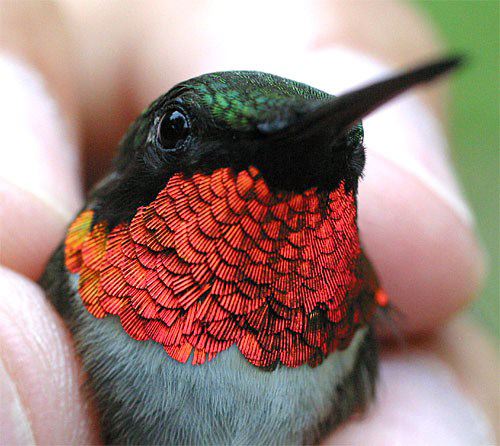 "HUMMINGBIRD MONTH" Most years, Ruby-throated Hummingbirds begin arriving at Hilton Pond Center the first week in April; our only bird earlier than that was an adult male (above) that showed up on 27 March 1991. Numbers gradually increase until mid-April, and then taper off again until late May when what looks for all the world like a second wave of migrants flies in (see chart below). After that, action at our nectar feeders diminishes for a while--undoubtedly because females are sitting for longers periods on eggs or chicks, and because natural food sources (i.e., flowers AND tiny insects) become much more plentiful. 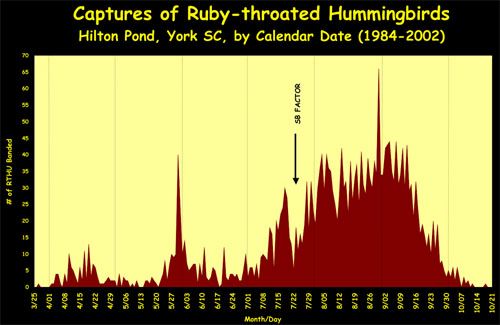 (Click on chart above for a larger version) Starting just before 1 July, more and more recently fledged juveniles take their first feeding forays, and then the combination of even more youngsters, resident birds, wanderers, and occasional early migrants from further north quickly drive the numbers steeply upward, making August a great month for watching and banding hummingbirds. That's an especially good reason for declaring August as "National (or even 'International') Hummingbird Month." After a frenzy of activity, the boom days of August go bust, the bottom falls out of the local population the first week in September, and 98% of our hummers are gone before the end of the month. Try as we might, it's hard to find hummingbirds locally in October, and we've never had a ruby-throat at Hilton Pond Center after the 18th.
Even though ruby-throats are indeed quite common in North America, there's a lot we don't know about their everyday behavior--much less details of their migration. It's also not clear what influences some ruby-throats to nest more than once in a season, or whether this behavior is more common in the South, or along the coast, or at lower altitudes. It would seem that more southerly breeders would have greater opportunity to double-brood, and that hummers up north would quickly run out of growing season--but that may not be the case. One thing we HAVE learned about Ruby-throated Hummingbirds through our banding work at Hilton Pond Center is that the species apparently produces lots more young males than females, but that more females survive to adulthood. Interestingly, young male ruby-throats look very much like females; they both have white throats (often streaked with green or black in juvenile males), and their outer tail tips are white (below left). Adult males look much different than they did as adolescents, sporting full red throats (top photo) and dark, forked tails with pointed feathers (below right). The best way to determine the sex of any white-throated ruby-throat after mid-May is to catch the bird and examine it closely for subtle differences in wing shape--an activity for which you must have a federal permit. 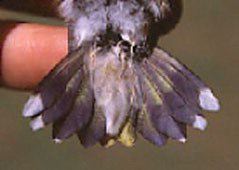 . .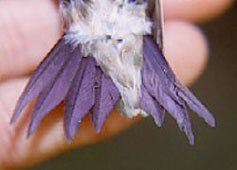 Perhaps by "masquerading" as females the inexperienced young males are able to avoid combat with territorially aggressive adult males, thus giving them a little better chance for survival. Some young males show their true colors by bringing in a few red gorget feathers while still in the U.S. or Canada, but most do not develop a fully red throat until their first winter in Mexico or Central America. The bottom line here is that even though we hear lots of people say they have tons of female ruby-throats coming to their feeders in July and August, it's highly likely they have a mix of adult females (below left), young females, and juvenile males--all of which look pretty much alike. During our 20 years of banding and studying Ruby-throated Hummingbirds at Hilton Pond Center, we've discovered all sorts of fascinating stuff, some significant, some a little more trivial. The annual Hummingbird Fest at Land Between The Lakes in Kentucky and Tennessee is a long way from Hilton Pond Center, but that's where we'll be on 1-3 August, giving hummer banding demonstrations and a lecture for what we anticipate will be hundreds of hummingbird enthusiasts. Hope to see you there or at one of our other Hummingbird Mornings events as we celebrate the annual arrival of "International Hummingbird Month." If you enjoy "This Week at Hilton Pond," please help Support Hilton Pond Center for Piedmont Natural History. It's painless, and YOU can make a difference!
|
||||
| Donate a portion of your purchase price from 500 top on-line stores via iGive: |
 |
|||
| Use your PayPal account to make direct donations: |
|
|||
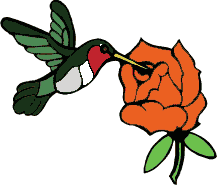 "HUMMINGBIRD MORNINGS" "HUMMINGBIRD MORNINGS"In 2003, informative and entertaining hummingbird banding presentations are scheduled at locations in North Carolina, Kentucky/Tennessee & Virginia. (Click on image at left for details.) the U.S. or Canada in 2003 or later, contact Bill Hilton Jr. |
 Please report your sightings of Please report your sightings ofColor-marked Ruby-throated Hummingbirds |
|
SPECIES BANDED THIS WEEK: * = New species for 2003 WEEKLY BANDING TOTAL 7 species 39 individuals
YEARLY BANDING TOTAL (2003) 46 species 728 individuals
BANDING GRAND TOTAL (since 28 June 1982) 123 species 42,842 individuals
NOTABLE RECAPTURES THIS WEEK (with original banding date, sex, and current age) Ruby-throated Hummingbird (3) Carolina Wren (1) Northern Cardinal (2) Eastern Towhee (1) |
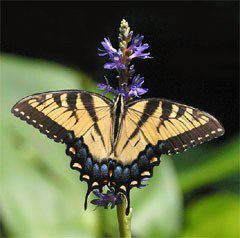 --On several days this week a female Eastern Tiger Swallowtail, Papilio glaucus, competed with bees, wasps, and hummingbirds that apparently found irresistable the nectar from flower stalks of Pickerelweed, Pontederia cordata, which grows in a small garden pool beside the old farmhouse at Hilton Pond Center. 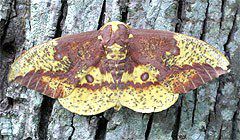 --And on the evening of 30 Jul, we were alerted by a thumping sound on the office window as a big male Imperial Moth, Eacles imperialis, tried to fly toward the inside lights over our computer desk. We carfeully captured it, placed it in a box, and transferred it the next morning onto the trunk of a Shagbark Hickory, Carya ovata. The 5" moth sat there just a moment with its wings quivering and flew straight up and disappeared into the foliage--just after we snapped off one photo (above). |
|
Up to Top of Page Current Weather Conditions at Hilton Pond Center |
 post questions for The Piedmont Naturalist |
Join the |
Search Engine for |
|
|